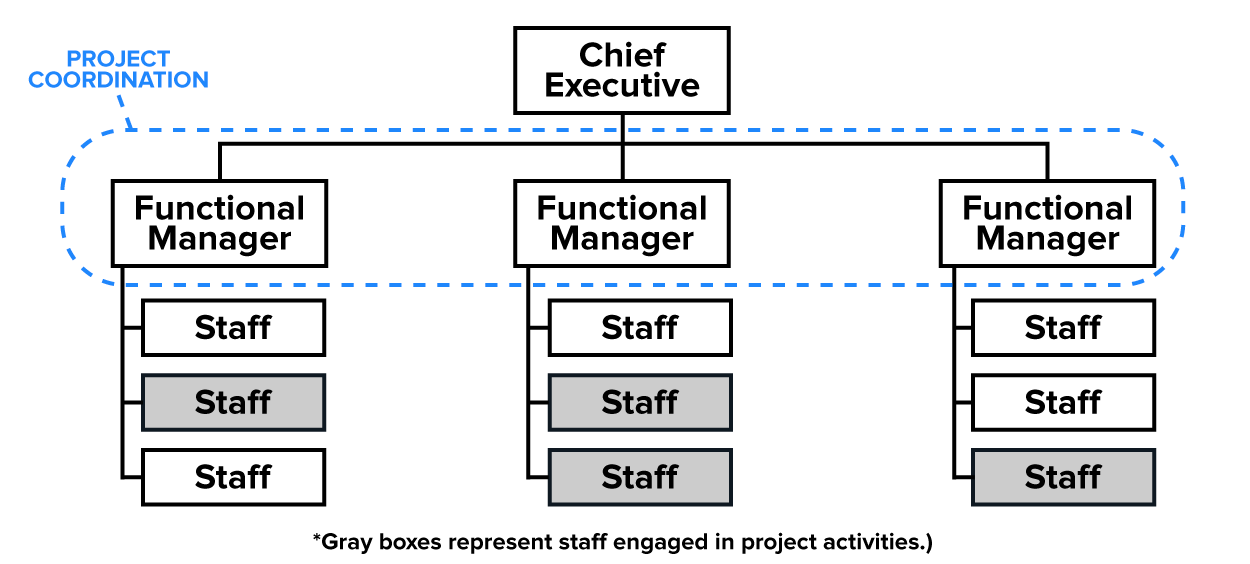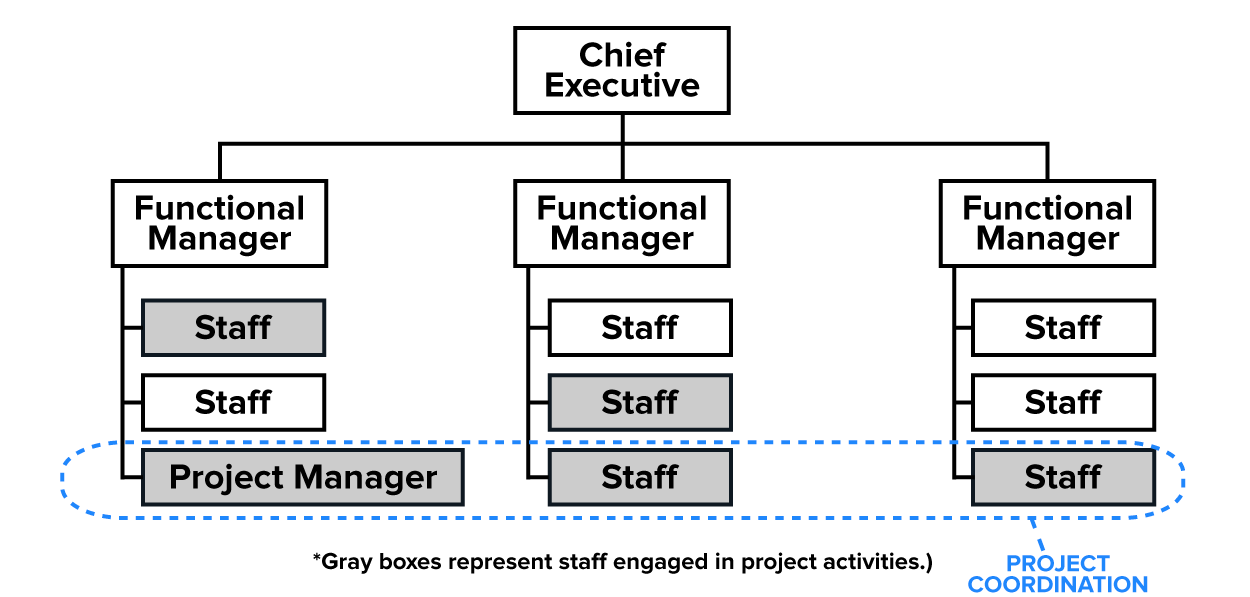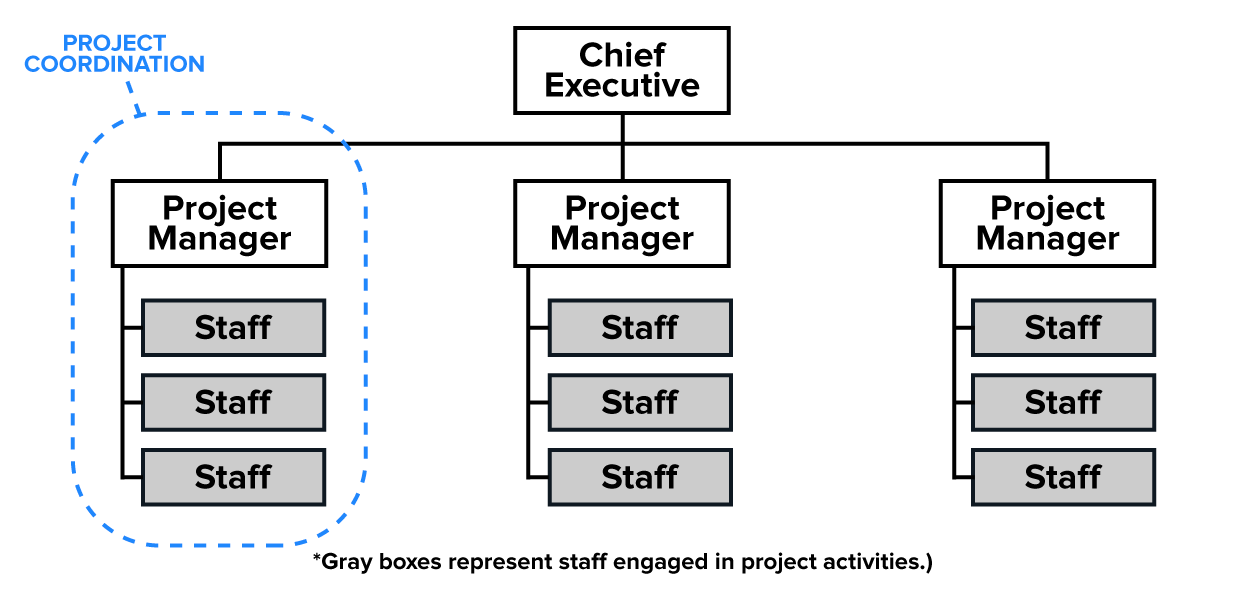Table of Contents |
Organizational structure significantly impacts project management by defining reporting lines, resource allocation, and authority. The three primary structures are functional, matrix, and projectized, each with varying degrees of project manager influence. The chosen structure affects how projects are managed, resources are allocated, and decisions are made.
The importance an organization places on a project directly influences the chances of the project’s success.
EXAMPLE
A project manager should check how a project aligns with the organization’s main goals, based on its structure (matrix, functional, or projectized). Four key documents help ensure the project meets the organization’s needs and objectives:Organizational structure refers to how various tasks are divided, resources are deployed, and units/departments are coordinated in an organization. An organizational structure includes a set of formal tasks assigned to individuals and departments, the formal reporting relationship, and a design to ensure the effective coordination of employees across departments/units with authority, reliability, responsibility, and accountability, which are fundamental to developing organizational structures and workflows that are clearly understood by all employees. In discussing organizational structure, the following principles are important:

Authority and responsibility can be delegated to lower levels in the organization, whereas accountability usually rests with the individual. Yet, many executives refuse to delegate and argue that an individual can have total accountability just through responsibility.
Traditional groupings of jobs result in different organizational structures, and these impact project management because of possible conflicts in authority, responsibility, and accountability.
There are many organization types, but we will focus on the following in this lesson:
A functional organizational structure is hierarchical, grouping employees by specialized roles like marketing, finance, or operations. Each department is led by an expert functional manager. This setup promotes efficiency, specialization, and clear accountability. Employees have clear reporting lines and authority within a vertical structure. Departments are specialized, grouping employees based on their skills in areas like marketing, sales, finance, or engineering. Decisions are typically made at the top and passed down through the hierarchy. Each employee has specific responsibilities within their department, ensuring everyone knows what to do.
Note: The use of the project coordination component for organizational structures

A matrix organizational structure organizes workers and resources across activities. It has pros and cons, helping decide if it’s right for a company. Every company organizes based on goals, setting rules for work and roles using the best tools.
In project management, a matrix structure is popular because it focuses on project results and management. Employees are organized by roles and products they work on simultaneously. Companies form teams to utilize strengths and cover weaknesses.
In a matrix structure, employees with similar skills are grouped and report to multiple managers. This setup, like a grid, involves a functional manager overseeing projects and a product manager ensuring strategy and product success. Large multinational companies use this structure to share skills and knowledge across departments to achieve goals.

In a projectized organizational structure, the company is organized around projects. Project managers have significant authority and control over resources dedicated to each project. Teams are created specifically for each project and disbanded when it finishes. This model is common in consulting, construction, and software development, where the focus is on completing projects. Key features include a strong project focus, with managers controlling resources, budgets, and decisions. Teams form for specific projects, but they face job insecurity after a project ends. Communication flows horizontally, with the project manager as the central contact. The organization has a flat hierarchy, with few layers between sponsors and the project manager. Resources are allocated to projects, with project managers deciding their use.

A functional organizational structure groups employees by specialized roles, enhancing efficiency and accountability. The matrix structure combines role and product management, promoting collaboration and flexibility. In a projectized structure, companies focus entirely on projects, granting managers significant control but possibly causing job insecurity post project.
Each structure serves different organizational needs. Review the table to get an overview of the aspects of each structure type and how they relate specifically to project management.
| Structure Type | General Characteristics | Impact on Project Management |
|---|---|---|
| Functional |
|
|
| Projectized |
|
|
| Matrix |
|
|
Many large and even medium-sized organizations have created a department to oversee and support projects throughout the organization. This is an attempt to reduce the high numbers of failed projects; these offices are usually called the project management office or PMO (Monteiro et al., 2024).
A project management office (PMO) is a team or department within an organization that supports project management. It can be the main hub for project managers or just a resource for them. Its goals include aligning projects with organizational objectives; providing templates, training, and mentorship; and staying updated on project management trends. PMOs also store project reports and lessons learned. PMOs can change or be disbanded if they don’t improve project success. If you work in or with a PMO, use its resources wisely and focus on helping project managers succeed without creating unnecessary barriers.
It’s important to see how PMOs work in different industries to understand their flexibility and how they help organizations succeed. PMOs can be supportive, controlling, or directive, each with different levels of control over projects. Let’s learn about these types!
A supportive PMO serves as a helpful guide and resource for project teams. Its main role is to act as a consultant, providing useful tools, templates, and best practices to help projects run smoothly. This type of PMO does not have much control over how projects are carried out; instead, it focuses on giving support and advice. Supportive PMOs are best suited for organizations that are new to project management or those that want to improve their current processes.
A controlling PMO has a more hands-on role than a supportive PMO does. It is responsible for enforcing project management standards and ensuring that everyone follows established processes and rules. This type of PMO has a moderate level of control over projects, which means it makes sure that project teams stick to the guidelines and frameworks that have been set up. Controlling PMOs work best in organizations that have reached a moderate level of project management maturity or those that need to make sure their processes are consistent across different projects.
A directive PMO takes the most active role among the three types. It directly assigns project managers and closely oversees the execution and delivery of projects. This PMO has a high degree of control because it gets involved in the day-to-day management of projects. Organizations with a high level of project management maturity benefit the most from a directive PMO, especially if they require strong coordination and oversight across several projects at once.
The best PMO model is selected based on size, industry, and existing project management maturity. We can review some scenarios so that you are aware of the differences.
| PMO Types and Scenarios | |
|---|---|
| PMO Type | Scenario |
| Supportive PMO |
Imagine a company that just started getting into project management. It doesn’t have much experience.
It sets up a supportive PMO for support. The PMO acts like a coach, providing the team with templates for planning projects and sharing best practices on how to manage time and resources. For instance, if a team is working on launching a new product, the supportive PMO might offer a template for creating a project timeline and some tips on how to run effective team meetings. However, the team still makes its own decisions on how to use these tools and advice, allowing them the freedom to manage the project as they see fit. |
| Controlling PMO |
In another company, project management is a bit more established, but it wants to ensure consistency across all of its departments.
It sets up a controlling PMO to enforce standards and processes. For example, if the company is planning to upgrade its IT infrastructure, the controlling PMO would ensure that all IT project teams follow the same project management guidelines and use approved software tools. The PMO checks in regularly to make sure teams are sticking to the rules, providing a moderate level of oversight to maintain quality and consistency. |
| Directive PMO |
A large corporation with a high level of project management maturity might use a directive PMO.
This PMO takes charge by assigning specific project managers to lead projects and gets involved in day-to-day activities. For example, if the corporation is planning a major expansion into a new international market, the directive PMO would assign a project manager and closely monitor the project’s progress. The PMO would ensure that all parts of the project, from budget management to team coordination, are handled efficiently. This high level of control helps the company achieve its goals with precision and coordination. |
Source: THIS CONTENT HAS BEEN ADAPTED FROM PRESSBOOKS "NSCC PROJECT MANAGEMENT” BY ADRIENNE WATT. ACCESS FOR FREE AT https://pressbooks.atlanticoer-relatlantique.ca/projectmanagement/ LICENSE: CREATIVE COMMONS ATTRIBUTION 4.0 INTERNATIONAL
REFERENCES
Monteiro, A., Varajão, J., & Santos, V. (2024). Project management office typologies, types, and functions: A systematic analysis of the literature and directions for research. Project Management Journal.